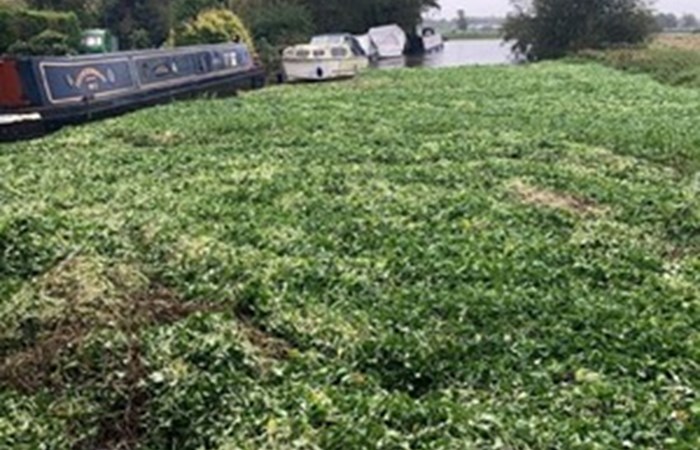Environment Agency

Last week, the field team pulled a fallen tree out of the River Wey at Newark, near Ripley, in Surrey. The tree fell into the river during last months storms, and there was a risk of it washing up onto Newark Weir and preventing it from working properly.
The team also cleared a huge raft of floating pennywort that had washed onto Newark Weir during last months stormy weather. Weirs are essential for managing water levels in rivers. The weed caused a significant blockage, preventing water from flowing unimpeded. Water levels upstream rose rapidly, and flooded onto adjacent land.
Unable to access the weir itself at the time due to the dangerous conditions, the Wey field team helped one homeowner to move furniture out of harms way before the conservatory flooded.
Maria Herlihy, operations and waterways manager for the Environment Agency in Surrey, said:
Usually, floating pennywort that poses a flood-risk is removed by boat, but river conditions were far too dangerous for this.
Over the course of several days, Environment Agency officers painstakingly removed as much of the weed blocking the weir as they could by hand, once the water pressure had reduced enough to allow them to work safely.
These are just two examples of the winter readiness work the Environment Agency carries out in the Thames Valley and Surrey to protect communities from flooding over the wetter winter months.
Maria added:
We urge everyone to prepare for the winter months.
Find out if your home or business is at risk from flooding, sign up to flood warnings, and make a flood plan so you know what you will do if you receive a warning.
Call Floodline on 0345 988 1188 or visit www.check-for-flooding.service.gov.uk to find out more.
Background
- The Environment Agency is responsible for managing the risk of flooding from main rivers, reservoirs, estuaries and the sea, and increasing the resilience of people, property, and businesses to those risks.Its top priority is keeping communities safe.
- Officers work year-round to ensure they are trained and ready, with sufficient flood-risk management in place to protect lives and livelihoods every winter, wherever they are needed.
- The Environment Agency has a huge maintenance?programme throughout the year to ensure all its flood risk management assets, like flood defences, are winter-ready.
- The Agency routinely inspects its defences and the defences of others and prioritise repairs to minimise flood-risk. Emergency repairs straight away where there is an immediate danger of flood. Contingency plans are put in place if this is not possible.
- Field teams do regular flood runs to check river channels for pinch points where flood waters might build up. This includes weed cutting, removing blockages, desilting, as well as dredging where they know it will make a difference and not make flooding worse downstream.
- Floating pennywort was originally introduced to the UK from the Americas as an ornamental pond plant. A highly invasive species, in warmer months it can grow up to 20cm a day, forming dense rafts of vegetation on the surface of rivers and shallow waters. Each year, Environment Agency field teams reduce the range of floating pennywort on rivers such as the Wey, as part of their annual maintenance programme.
- Please report sightings of floating pennywort to the Environment Agencys incident hotline on 0800 80 70 60. More information is available from the Non-Native Species Secretariat at www.nonnativespecies.org
Contact us
Media enquiries: 0800 141 2743
